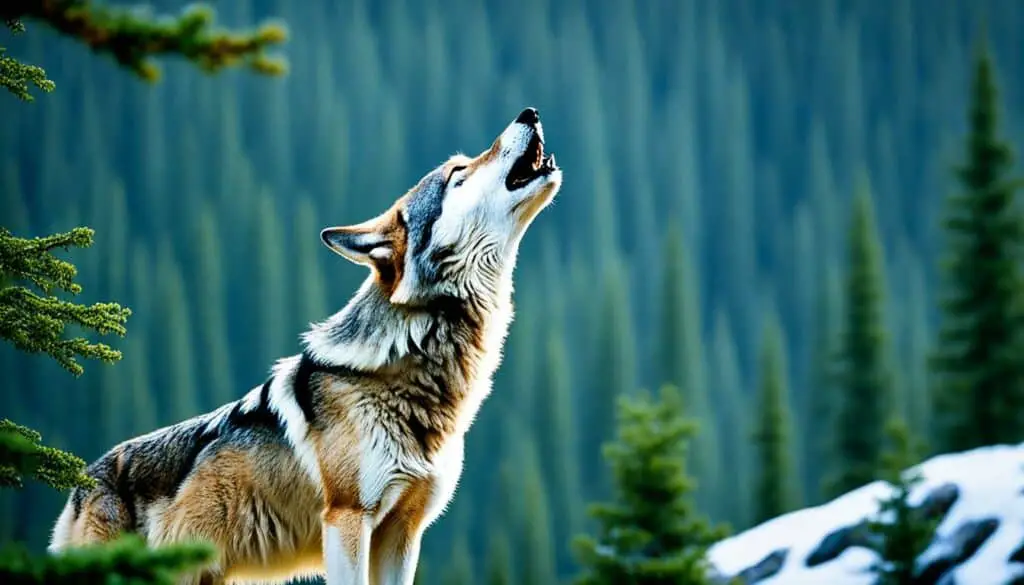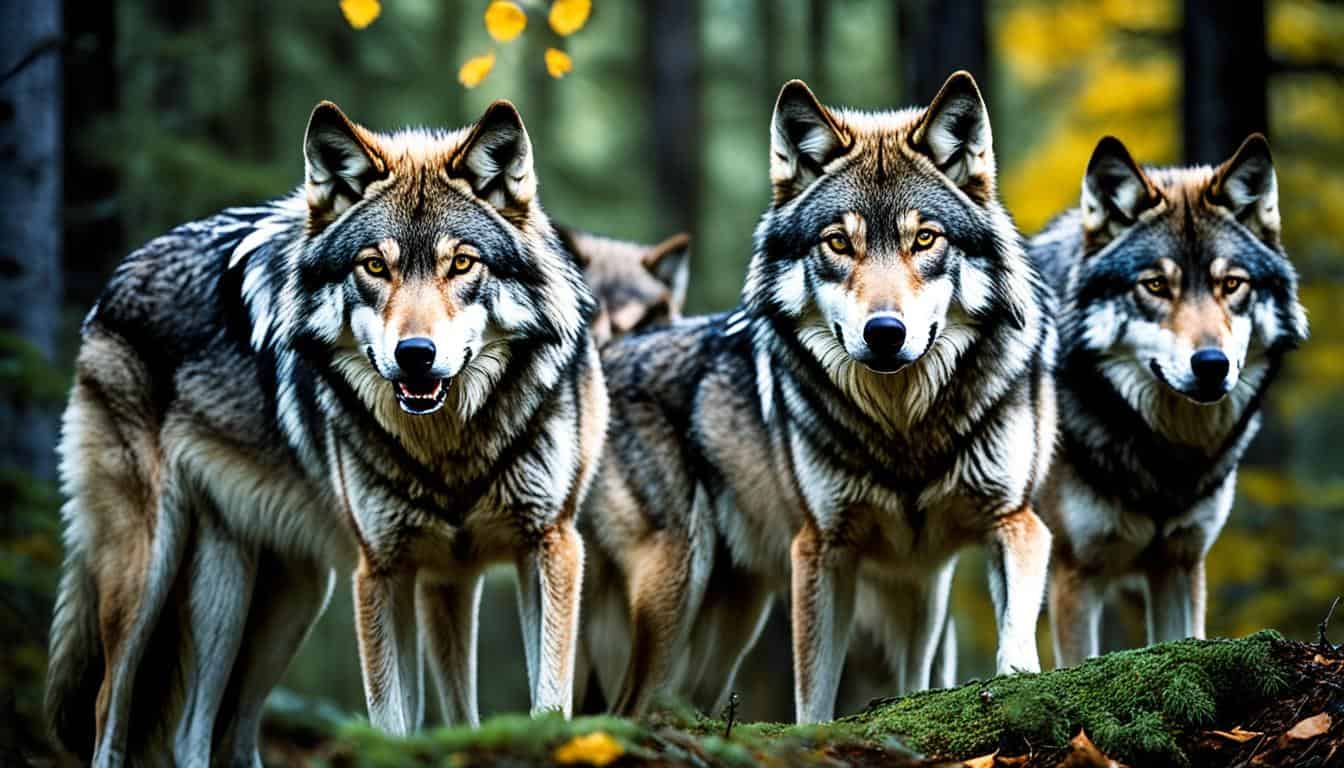Have you ever wondered if wild wolves still live in America’s forests and mountains? Despite hard times from European settlement and hunting, they have made a big comeback.
Wolves are key to America’s nature and its native cultures. Different types of American wolves now again live in certain spots, adding to the country’s diverse wildlife. Their journey from almost disappearing to thriving is truly incredible.
Wanna know how these tough, wild dogs in the U.S. bounced back? Plus, where you might see them in the wild? Keep reading to find out.
Current Status of Wild Wolves in the USA
In the past, gray wolves (Canis lupus) covered a wide area. They lived throughout the northern part of the world. Yet today, they are found in only about 10% of that area in the USA. Thanks to conservation efforts, the population of wolves in the USA has started to increase in various places.
Conservation efforts are making a big difference for American wolves. These include efforts to protect and manage wolf populations. Places like the Northern Rockies, the Pacific Northwest, and the Great Lakes are seeing more wolves. This is a good sign for their recovery.
The growth in their numbers shows a positive change from the past. Wolves are holding on in these places. This highlights the need for ongoing conservation work. It is vital to keep wolves in the American wilderness.
Now, let’s look at how wolf recovery is going in different parts of the USA:
| Region | Conservation Status | Gray Wolf Populations |
|---|---|---|
| Northern Rockies | Stable | Increasing |
| Pacific Northwest | Expanding | Moderate |
| Great Lakes | Protected | Healthy |
Historical Decline and Revival of Wolves in America
The story of wolves in America is about survival and strength. When Europeans came, wolves started to disappear. This was because they were seen as risks to farm animals. So, many were killed in campaigns across the land.
The Early Extermination Campaign
From the 1800s to early 1900s, wolves were being wiped out in huge numbers. People and officials offered money to kill wolves, calling them dangerous to farms. This made their numbers drop a lot, almost leading them to vanish.
Reintroduction and Protections Under the ESA
In 1974, the Endangered Species Act was passed. This was a big change for American wolves. It gave them protections and allowed people to bring them back in some places. This made great things happen, especially when gray wolves returned to Yellowstone Park.
Thanks to these actions, we’ve seen how much can change with effort. The wolf story in America shows the hard work and the good results in keeping our wild animals alive.
Regions in the USA Where Wild Wolves Are Found
Knowing where wolves live in the USA helps us understand their world better. Each area supports a different type of wolf, with its struggles and beauty. This info is key to protecting them for the future.
Pacific Northwest
The Pacific Northwest shines as a home for gray wolves. With efforts to save them getting better, their numbers grow. Thick forests and lots of food mean they’re doing well here.
Northern Rockies
Montana, Idaho, and Wyoming welcome gray wolves. Thanks to projects like those in Yellowstone, these wolves are making a comeback. More of these wild areas see their return again.
Southwest
The Southwest shelters the Mexican gray wolf, in danger and spread thin across Arizona and New Mexico. Big plans are in place to help them grow in number, and find more places to live in the USA.
Great Lakes
The Great Lakes area supports many gray wolves. Big forests and lots of food help keep their numbers up. They play a vital role in our world.
Southeast
The red wolf fights for survival in North Carolina. Efforts there are crucial to keep their numbers from dropping more. Saving this place means saving an important type of wolf.
Below is a summary of the current status of wolves across different regions:
| Region | Subspecies | Conservation Status |
|---|---|---|
| Pacific Northwest | Gray Wolf | Increasing |
| Northern Rockies | Gray Wolf | Stable |
| Southwest | Mexican Gray Wolf | Endangered |
| Great Lakes | Gray Wolf | Stable |
| Southeast | Red Wolf | Critically Endangered |
Native Wolf Species in the USA
The USA has many native wolf species, each unique and needing special attention. Known from the famous gray wolves to the rare red wolves, they are crucial to the wild. They help maintain the balance in various ecosystems across the nation.
Gray Wolves
Gray wolves (Canis lupus) are common among the native wolf species in the USA. They have several subspecies, varying across the country. Over time, they’ve improved in numbers thanks to conservation efforts and necessary laws.
Mexican Gray Wolves
The Mexican gray wolves (Canis lupus baileyi) are found mainly in the Southwest. Considered one of the rarest wolves, they have faced severe endangerment. But with focused efforts, their population is slowly growing in the wild.
Red Wolves
Red wolves (Canis rufus) live mostly in the Southeast. They are critically endangered. Programs are working hard to protect their homes and help them live safely near people.
| Wolf Species | Scientific Name | Primary Region | Conservation Status |
|---|---|---|---|
| Gray Wolves | Canis lupus | Various, including Northern Rockies and Great Lakes | Least Concern |
| Mexican Gray Wolves | Canis lupus baileyi | Southwest | Critically Endangered |
| Red Wolves | Canis rufus | Southeast | Critically Endangered |
Are there wild wolves in the USA?
The existence of wild wolves in America shows how they’ve adapted to survive. Over time, wolves faced tough challenges like losing their homes and being hunted. But they’re still found in many parts of the USA today.
Conservation efforts have played a big role in helping current wolf populations in the USA. Projects to restore their habitats and laws to protect them are keeping these animals part of America’s nature.
Recent data from sightings and tracking show wolves are still around in many states. Tracking their movements helps us learn about their habits. This, in turn, helps improve how we protect them.
The fact that current wolf populations in the USA are growing shows the power of working together. Wildlife lovers and local communities are key. With their support, the future looks bright for wild wolves in America.
Conservation Efforts to Protect Wild Wolves
In America, many efforts are now in place to protect wolves and help them grow in numbers. These efforts focus on a few key areas.
- Legal Protections: Wolves are now protected by laws like the Endangered Species Act. These laws stop hunting and protect their homes, key in protecting American wolves.
- Habitat Restoration: People are working to make wolf living spaces better. They connect lands and make sure wolves have places to live without people getting in the way.
- Public Education: Learning about the role of wolves in nature is very important. These programs teach people the truth and how to live with wolves without conflict.

“An important milestone in our journey is changing public perception about wolves. By highlighting their ecological role, we can better advocate for their protection,” states a representative from the Defenders of Wildlife.
Here’s a look at the main strategies being used:
| Strategy | Description | Impact |
|---|---|---|
| Legal Protections | Setting up laws like the ESA | Keeps wolves safe from direct danger |
| Habitat Restoration | Making lands better for wolves | Creates more places for them to live |
| Public Education | Teaching about wolves and how to live with them | Improves the relationship between people and wolves |
These strategies work together to save wolves and the slots they fill in nature. With all these efforts, the future looks bright for these amazing animals.
Wild Wolf Sightings and Tracking in the US
Monitoring wild wolves is key for knowing their behavior and populations in the USA. Advanced tracking methods, citizen reports, and teamwork of many groups help keep an eye on them. This data is critical for making smart choices about saving these animals.
Tracking Techniques and Tools
Today, we use GPS collars, cameras, and drones to watch wolves. These help us learn where they move, what areas they like, and how they interact. Technology, along with old-fashioned fieldwork, makes keeping an eye on wolf groups easier than ever.
Citizen-Reported Sightings
Your help is gold when you see a wild wolf and report it. Thanks to people like you, a bigger group helps track these animals. Your stories help us know more about where wolves are and how often they’re seen. This is a big deal for keeping them safe.
Government and Nonprofit Monitoring Programs
Groups like the U.S. Fish and Wildlife Service and Defenders of Wildlife do a lot to watch over wolf numbers. They regularly check on wolves, work on their homes, and keep track of what people report seeing. Through this teamwork, they make sure we use the right info to protect these animals better.
Wolf Population Statistics and Trends
Knowing how wolf populations change is key to protecting our world and its creatures. Recent American wolf population statistics show wolves are making a comeback in the U.S.
The numbers of wolves across the U.S. have stayed fairly constant. This is thanks to lots of hard work in saving them. Let’s look closer at how wolf populations are doing in different areas:
| Region | Current Population | Trends Over the Last Decade |
|---|---|---|
| Pacific Northwest | Approximately 200 | Increasing |
| Northern Rockies | About 1,700 | Stable |
| Southwest | Estimated 186 | Gradual Increase |
| Great Lakes | Roughly 4,000 | Fluctuating |
| Southeast | Fewer than 30 | Critically Endangered |
This chart shows how wolf numbers are changing in different places. These changes are due to unique efforts to save them and local conditions. For example, wolves in the Pacific Northwest are growing in number. In contrast, wolves in the Great Lakes region have varying populations. On the other hand, the Northern Rockies area shows stable figures. This shows that work to protect these animals is paying off.
Understanding these trends helps shape future efforts to protect wolves. It aims to encourage the positive growth of wolf populations all over the U.S.
Challenges Facing Wolf Conservation in the USA
Wolf conservation in the USA faces many problems. Habitat loss, conflict with humans, and changing laws are key issues. As cities grow and farms spread, wolf habitats shrink. This makes it hard for wolves to live and find food and mates. It lowers their numbers and affects their genes.
People and wolves often don’t get along in the US. This is a big problem for wolf survival. People in rural areas see them as threats to their animals and incomes. They sometimes kill wolves to protect what’s theirs. It’s important to find ways for wolves and people to live together. Protecting farms and teaching about living safely with wolves could help.
Laws also change how well wolves are looked after. The Endangered Species Act has been a big help. But, new laws and leaders might take away these safeguards. We need to keep up protection for wolves using what science shows is best. This way, wolves can hope for a better future in the US.
FAQ
Are there wild wolves in the USA?
Yes, wild wolves live in the USA. They are of various types, like gray, Mexican, and red wolves. They dwell in places such as the Pacific Northwest and the Southwest.
What is the current status of wild wolves in the USA?
Wild wolves are slowly returning in the USA. Efforts to protect them have allowed their numbers to grow. But, they live in only about 10% of their old territories. Keeping them safe and making more homes for them is very important.
How did wolves historically decline in America?
Many wolves were killed, especially after people from Europe came. They were seen as danger to farm animals. This led to campaigns to kill them, almost wiping wolves out. It wasn’t until later that laws to protect them were made.
What role did the Endangered Species Act (ESA) play in wolf conservation?
The Endangered Species Act changed the game for wolf protection in 1974. It made killing wolves illegal and helped bring them back to places like Yellowstone. Because of this law, wolves have started to thrive again.
Where can wild wolves be found in the USA?
In the USA, wild wolves can be seen in a few different areas:
- Pacific Northwest: This area includes states like Washington and Oregon, where gray wolves live.
- Northern Rockies: Places like Montana and Idaho are big areas for wolves.
- Southwest: In the Southwest, Mexican gray wolves live, especially in Arizona and New Mexico.
- Great Lakes: States like Minnesota and Michigan have their share of wolf populations.
- Southeast: The Southeast is home to the rare red wolves, primarily in North Carolina.
What are the native wolf species in the USA?
Various types of wolves are native to the USA:
- Gray Wolves (Canis lupus): They live in many regions.
- Mexican Gray Wolves (Canis lupus baileyi): These are a unique type, mostly living in the Southwest.
- Red Wolves (Canis rufus): They are in danger and found mainly in the Southeast.
Are there wild wolf sightings in the USA?
People are seeing more wild wolves in the USA. This tells us they are still out there. GPS and reports from the public are helping to keep track of them.
What conservation efforts are being made to protect wild wolves?
A lot is being done to save wolves. This includes laws to protect them, fixing their homes, and teaching the public. The government and groups work together on this.
How are wild wolves tracked in the USA?
To track wolves, we use special gear like GPS collars and cameras. People are also asked to tell us if they see a wolf. The government and charities watch over wolves too.
What are the current wolf population statistics and trends in the USA?
More wolves are living in the USA now. Thanks to hard work, their numbers are increasing. This shows that our actions to protect them are working, and wolves are coming back strong.
What challenges does wolf conservation face in the USA?
Wolf conservation is not easy. We have to fight against losing their homes and problems between people and wolves. Laws that change can also cause issues. Overcoming these challenges will help ensure our wolves and the wild stay healthy.







